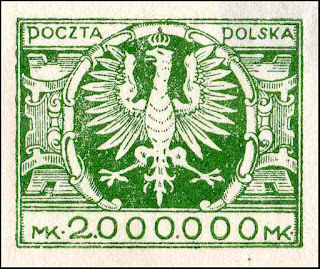Hawaii's second issue featuring King Kamehameha III was produced by intaglio printing in Boston, thus the name "Boston Engraved."
They are assigned Hawaii Nos. 5-9 in Scott Catalogue.
Only two denominations were printed, 5c and 13c and issued in 1853
The 5c value paid the Hawaiian domestic foreign mail charge to handle a letter and deliver it to a ship bound for San Francisco.
The 13c value paid both the Hawaiian 5c rate and the United States 6c rate from San Francisco to the Eastern States plus a 2c ship value.
Given their high value, few collectors will ever own the originals.
But they make an interesting subject given the abundant forgeries.
The main problem for collectors are the relatively affordable reprints passed off as "originals"
 |
| Trial color proof on thick wove paper |
Given the need for five cents a new supply was made from the same plates used for the 1853 printing on a thin chalky white paper in 1857.
These stamps are designated Scott 8.
In 1860, a new five cents printing was ordered made from the same plate.
These stamps were printed on a thin bluish paper and are designated Scott 9.
Both issues are on paper so thin the reverse clearly shows the design
They both have the same features as the 1853 stamp.
Genuine features
5C
- There is a tiny dot opposite the left 5 near the frame line
- There are 2 dots below the image in the value tablet
13c
- The vertical frame lines all extend to the edges - not in some forgeries
- The numeral 3 has a protrusion on the right side, it varies in size and clarity depending on the plate position and can be used to determine the position.
- The right side outer frame line is doubled.
genuine 1857 type I applied by clerk Alvah Clark
Rare type II applied by postmaster Jackson
1857 re-issue Sc 7 on thin white paper
Re-issue Sc 11
Forgeries
Spiro forgery- Immediately identified by the dot in a white space on the chin
- Typical 4 ring cancel
- No double right frame line
Torres forgery- These are very close to the Spiro but without the chin dot
- The 5c has a typical Torres cancel
- Obviously some relationship with Spiro
Moens forgery- Facial features are crude
- The eye on the right is higher than the one on the left
Forgery attributed to
W. Scott- Thick letters and odd eyes
Unknown forger
Decent forgery
- Lacks the original features
- Eyes are very different
Unknown forger
- Thick tall letters
Forger unknown
- Very crude
- Wide nose and odd eyes
Forger unknown
- Very good forgery
- Lacks genuine features
- 5's are narrower
- Odd blemish above the eye on the right
Forger unknown
- Overall pale shading
- Letters are smaller, narrow H
- Double outer frame
Forger not determined
- Speculation it is a period privateer "Bully Hayes" and it is so named
- Very crude with tall thin letters
- Large 5's
- Considered "dangerous" but I differ
- It has features similar to the original but the facial ones are different and the shading is very different
- Many horizontal lines in the tunic are broken and the buttons are larger
Extremely primitive
Unknown forger
- Lacks all the features of the original
- Letters are short
- The 3's do not line up with the 1's
- Eyes are very different
Forger unknown
- Lacks all the genuine features
- Face is heavily shaded
- Cancel is similar to one found on Spiro forgeries
poor forgery -unknown forger
- Letters & numbers uneven
- Face very different
- C of Cts looks like a 6
Very crude design -forger unknown
- Facial feature distorted
- Heavy background lines
- All the letters are uneven
Samuel Taylor forgery right, genuine left
- Probably the most dangerous and like most Taylor's is probably common
- It does lack genuine features and the arrows point to the major differences
History behind the forgery
S. Allen Taylor, a member of the “Boston Gang” of stamp forgers arranged for its creation.
In 1867 Taylor visited Holland Printing Co. and convinced the engraver of the die of the original stamp, Nathaniel Dearborn, into printing a new batch from the original plate.
Dearborn agrred but requested that some minor changes be made such as removing the dot after "STATES"
Some incident with Taylor made Dearborn reluctant to produce a 5c copy
Later Taylor put back in the items Dearborn corrected so there are 2 "Taylor" forgeries
Taylor added a fake Honolulu postmark to some of his forgeries but mistakenly used black ink instead of the period red
Fournier
It is an established fact that Fournier was a dealer in forgeries than an actual forger.
His forgeries have been identified from about 10 sources
These are from my collection
Addendum
In 1874 the PO ordered remainders of the 1868 re-issues overprinted with "SPECIMEN" by the original printers, Pacific Commercial Advertiser. This was basically done for demand from collectors.































.%20Type%20I%20(.jpg)

.jpg)




















